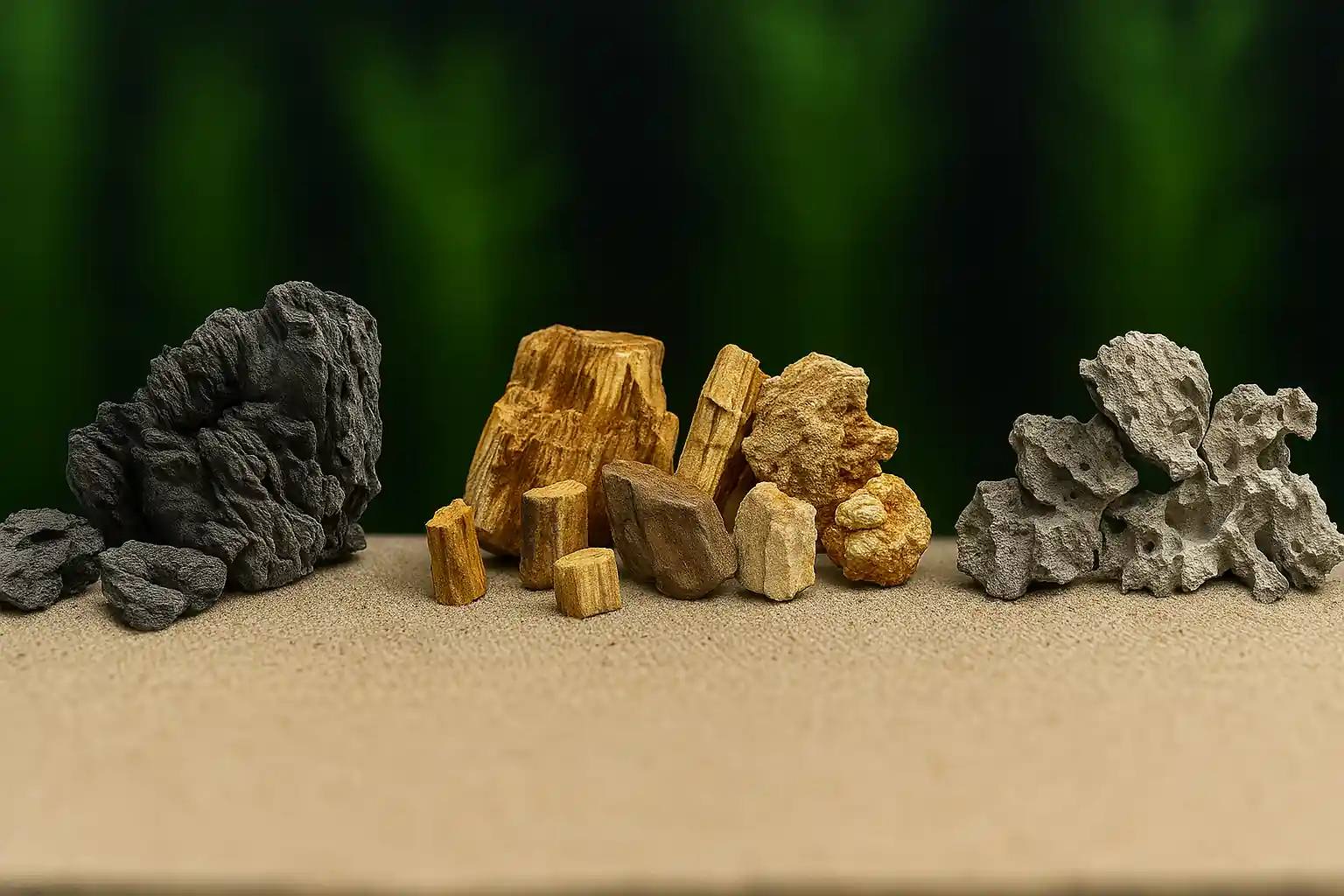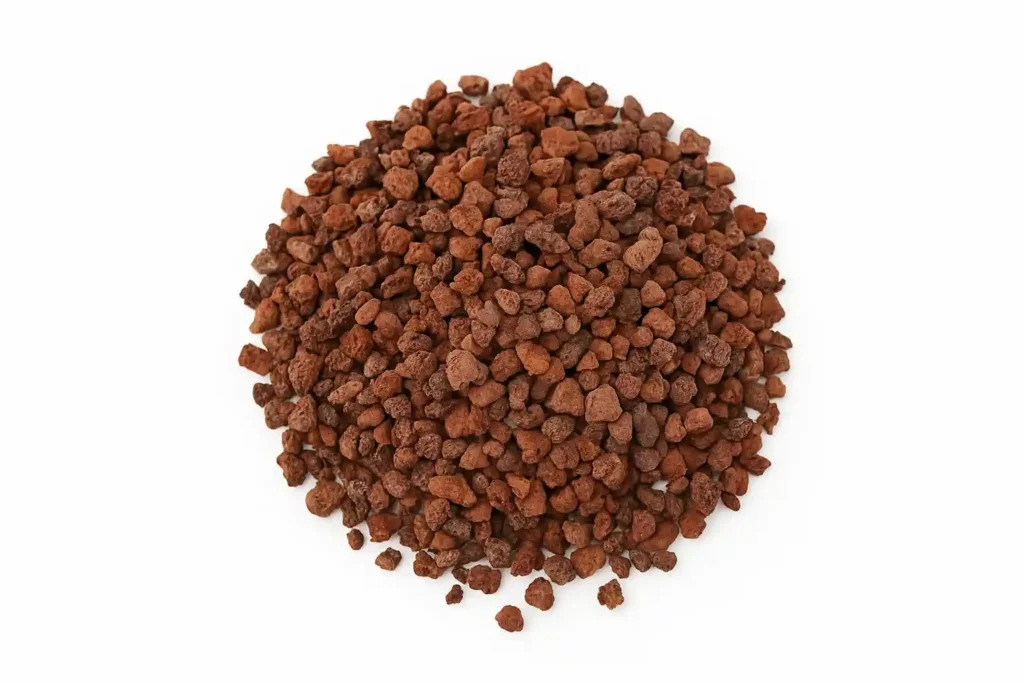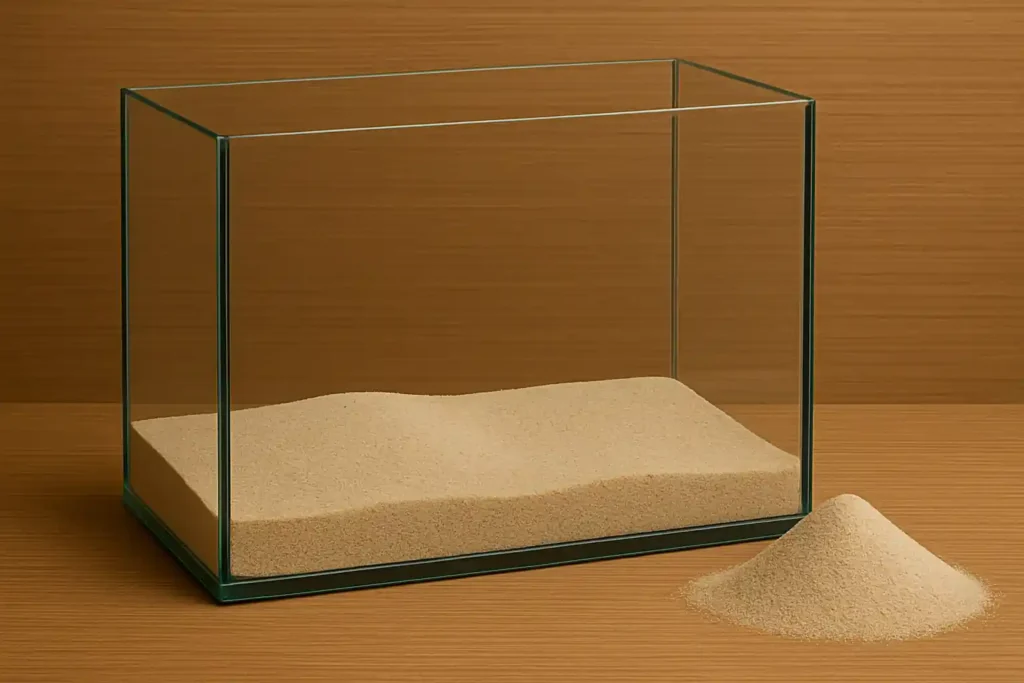
Aquarium Rocks Guide: Types, Aquascaping, Safety & DIY Setup
Introduction
Aquarium rocks are more than just decoration—they’re a powerful aquascaping tool that can shape the layout, improve habitat structure, and influence your tank’s chemistry. Whether you’re crafting a minimal Iwagumi-style scape or building caves for cichlids, choosing the right aquarium rocks is essential for both beauty and functionality.
In this guide, you’ll learn everything you need to know to safely use rocks in your aquarium—from selecting the right type to arranging them like a pro.
What you’ll learn in this lesson
- What makes aquarium rocks essential for aquascaping
- The benefits of rocks for layout, structure, and fish behavior
- Popular aquarium rock types and how they influence water chemistry
- How to test rock safety using the vinegar test
- Where to buy or how to collect aquarium rocks safely (DIY guide)
- Step-by-step rock cleaning and preparation techniques
- Aquascaping styles that use rocks (Iwagumi, cichlid tanks, dioramas)
- How to combine rocks and driftwood for a natural hardscape
- Tips for stacking and securing rocks without damaging your tank
- Best fish and plants for rock-based aquascapes
- A visual rock compatibility chart for quick reference
- Comparison: rocks vs. driftwood—pros, cons, and when to use each
- Troubleshooting common issues: shifting, algae, pH changes
- Frequently asked questions about aquarium rocks, pH, and sharp edges
What Are Aquarium Rocks?
Aquarium rocks are natural or synthetic stones placed inside aquariums to serve aesthetic, structural, and ecological functions. They’re used in aquascaping to shape layouts, mimic natural habitats, and support biological balance.
🪨 Why Use Rocks in Your Tank?
- Create depth, shadows, and elevation in the layout
- Provide hiding spots and territorial boundaries for fish
- Anchor plants and define pathways or scaping zones
- Offer surface area for beneficial biofilm and bacteria
Benefits of Aquarium Rocks
Using aquarium rocks goes far beyond looks. A well-placed rockscape can positively influence your fish’s behavior and water parameters.
✅ Structural & Aesthetic Advantages
- Adds contrast and vertical height to flat tanks
- Defines hardscape zones (foreground, midground, background)
- Ideal for minimalist styles like Iwagumi or Diorama scapes
🐠 Functional Benefits for Fish
- Provides cover and cave systems for shy or territorial species
- Encourages natural behaviors like grazing or spawning
- Helps divide territories in aggressive cichlid tanks
⚗️ Water Chemistry Influence
- Certain rocks (e.g. limestone) can raise pH and hardness
- Others (e.g. inert lava rock or seiryu stone) maintain stable parameters
- Can be used strategically to adjust water hardness
Note: Always test unfamiliar rocks before use, especially in soft water or shrimp tanks.
Popular Types of Aquarium Rocks
Different aquascaping styles call for different rock aesthetics, textures, and mineral content. Below are the most commonly used aquarium rocks and their ideal applications.
🔷 Seiryu Stone
- Sharp, gray-blue texture with white veins
- Ideal for Iwagumi layouts in planted tanks
- May slightly raise pH—test before use
🔶 Dragon Stone (Ohko)
- Lightweight, earthy-colored with holes and textures
- Popular in nature aquariums
- Inert and safe for most water parameters
🔲 Lava Rock
- Porous, dark red/black volcanic stone
- Great biological filtration surface
- Lightweight and plant-friendly
⬜ Slate
- Flat, stackable gray or black stone
- Used to build caves, ledges, or shrimp hides
- Inert and easy to shape
🟫 Texas Holey Rock
- White/cream rock with natural tunnels
- Raises pH and GH—perfect for African cichlid setups
- Too alkaline for soft-water species
🟩 Pagoda Rock / Mini Landscape Stone
- Layered sedimentary rock with dramatic textures
- Excellent for building cliff or plateau effects
Tip: Choose rocks not only by look, but also based on how they affect water chemistry and your tank’s inhabitants.
🧪 The Vinegar Test: How to Check If Aquarium Rocks Are Safe
Before adding any rock to your aquarium—especially if it’s collected or unlabelled—it’s crucial to know whether it will affect your water chemistry. The vinegar test is a simple DIY method to determine if a rock is reactive and may alter pH or hardness (GH/KH).
🧾 Why It Matters
Some rocks contain calcium carbonate or other minerals that can:
- Raise your tank’s pH or water hardness
- Stress fish that prefer soft, acidic water
- Cause unwanted algae growth in some setups
🧪 How to Perform the Vinegar Test
What You Need:
- Regular white vinegar (5–6% acetic acid)
- A clean dry rock sample
- A small bowl or plate to catch overflow
Step-by-Step:
- Dry the rock: The surface must be dry to detect any fizzing clearly.
- Apply a few drops of vinegar directly onto the rock’s surface.
- Observe closely:
- Fizzing or bubbling means the rock contains calcium carbonate → reactive
- No reaction means the rock is likely inert → safe for most aquariums
🧪 What a Positive Reaction Means
If the rock fizzes, it may:
- Gradually increase the alkalinity and pH of your tank water
- Be suitable for African cichlids or hard-water species
- Be unsuitable for planted tanks, shrimp, bettas, or soft-water fish
Note: Some stones (e.g. Seiryu, Texas Holey Rock) are mildly reactive and still used by aquascapers—but always test and monitor.
⚠️ Limitations of the Vinegar Test
- It’s a preliminary test—not 100% conclusive
- Won’t detect all minerals or impurities
- Large rocks may have mixed compositions, so test multiple spots
- For high-accuracy: test in a bucket of dechlorinated water and monitor pH over several days
How to Clean Aquarium Rocks
Even safe rocks must be cleaned thoroughly before use to avoid introducing algae spores, bacteria, or pollutants.
🧽 Cleaning Steps
- Scrub with a stiff brush under hot water
- Boil rocks (if size allows) for 10–20 minutes to sterilize
- For larger rocks:
- Soak in hot water for 24–48 hours
- Rinse thoroughly before placing in the tank
❌ What to Avoid
- Never use soap, bleach, or chemicals
- Don’t collect rocks from roadsides or polluted water bodies
- Don’t use rocks with shiny or metallic inclusions
Aquascaping With Aquarium Rocks
Rocks form the backbone of many aquascaping styles, especially minimalist and nature-inspired layouts.
🌿 Common Rock-Based Styles
🪨 Iwagumi Style
- Uses 3–5 carefully placed stones
- Focuses on minimalism and visual harmony
- Often paired with carpeting plants
🌄 Diorama Style
- Builds dramatic cliffs, valleys, or mountain scenes
- Combines rock elevation with driftwood and plants
🧱 Cichlid Rockscapes
- Emphasizes caves, tunnels, and territories
- Ideal for Lake Malawi or Tanganyika setups
🔄 Rocks vs. Driftwood in Aquascaping: Which Should You Use?
Both aquarium rocks and driftwood are essential tools in aquascaping—but they serve different purposes in your layout and influence your tank in distinct ways.
Choosing between them (or combining both) depends on your goals: design style, water chemistry, fish species, and personal preference.
⚖️ Key Differences at a Glance
| Aspect | Aquarium Rocks | Driftwood |
|---|---|---|
| Visual Aesthetic | Structured, bold, clean lines | Organic, natural, flowing shapes |
| Water Chemistry Impact | May raise pH (limestone, holey rock) | May lower pH via tannin release |
| Weight & Stability | Heavy and stable, stackable | Lightweight, may float unless soaked or anchored |
| Best for Layout Styles | Iwagumi, cichlid tanks, cliff or valley structures | Nature aquariums, blackwater tanks, rootscapes |
| Plant Attachment | Great for epiphytes, mosses | Excellent for attaching rhizome plants and mosses |
| Maintenance | Low—clean surfaces, minimal decay | Requires soaking, may decay slowly over time |
| Common Use | Base structure, caves, cliffs | Branches, roots, background framing |
🤔 When to Use Each
Use Rocks If:
- You want clean, minimalist or symmetrical layouts
- You’re keeping cichlids, loaches, or hard-water fish
- You need structural elevation or hiding caves
Use Driftwood If:
- You’re building a blackwater or Amazon biotope
- You’re adding shrimp, bettas, or soft-water tetras
- You want a flowing, forest-like scape with overhangs
Combine Both If:
- You want to add contrast, texture, and realism
- You’re designing complex root-over-rock layouts
- You want a tank that mimics nature closely
🌿 Combining Rocks and Driftwood in Hardscape Layouts
One of the most striking and natural-looking aquascapes comes from combining aquarium rocks with driftwood. When used together effectively, these two hardscape elements can replicate riverbeds, forest streams, and root-covered cliffs.
🔗 Why Combine Rocks and Driftwood?
- Enhances visual complexity and layering
- Balances sharp rock structures with flowing organic lines
- Mimics real-world underwater ecosystems
- Offers diverse surfaces for plants, mosses, and biofilm
🧭 Layout Ideas Using Both Materials
🪵 Rooted Stone Look
- Place large rocks at the base with spiderwood “roots” curling over them
- Perfect for jungle or forest stream themes
🪨 Cliff & Root Combo
- Use vertical slate or seiryu as background cliffs
- Add twisted driftwood rising from behind or emerging between cracks
🌊 Riverbed Style
- Scatter round rocks (pebbles, lava rock) on substrate
- Lay thick Malaysian driftwood horizontally to simulate sunken logs
📐 Design Tips for Blending Materials
- Use the same color temperature (cool-toned rocks with dark wood, warm with light)
- Place driftwood behind or through rocks for depth
- Keep focal points simple—avoid over-cluttering
- Consider plant placement on both surfaces to unify the design
⚠️ Things to Watch Out For
- Don’t mix reactive rocks (e.g., limestone) with acidic driftwood unless you want chemical balance shifts
- Avoid structural instability—test stacked combinations dry before adding water
- Make sure both materials are fully prepared (soaked, cleaned, tested)
Tip: When in doubt, start with one dominant material (rock or wood) and use the other as an accent.
Tips for Placing and Securing Rocks
Proper placement ensures stability, safety, and visual balance in your tank.
📐 Positioning Advice
- Use the Golden Ratio or Rule of Thirds for focal placement
- Combine different sizes for depth and perspective
- Slightly tilt or bury base rocks into the substrate for realism
🛠️ Securing Rocks
- Stack using flat stones for support
- Use aquarium-safe epoxy or superglue for fragile builds
- Always test stability before filling the tank with water
Pro Tip: Place a thin layer of egg crate or foam under heavy rocks to protect glass tank bottoms.
Best Fish and Plants for Rock-Based Layouts
Pairing your aquarium rocks with compatible species ensures a balanced, natural setup.
🐠 Ideal Fish Species
- African Cichlids – thrive with limestone and cave structures
- Plecos & Catfish – use rocks for shelter and grazing
- Hillstream Loaches – enjoy high flow and smooth rock surfaces
- Tetras & Rasboras – complement minimalist planted rock scapes
🌱 Compatible Plants
- Anubias and Bucephalandra – attach well to stone surfaces
- Java Moss – grows over textured rock for a natural look
- Riccia and Monte Carlo – perfect for carpeting around stones
- Cryptocoryne – adds volume between or behind large rocks
📊 Aquarium Rock Compatibility Chart
Choosing the right aquarium rock involves more than just looks—it’s about water chemistry, plant compatibility, and matching your tank’s inhabitants. This chart gives a quick overview of popular rock types and how they perform in key categories.
| Rock Type | Affects pH? | Plant Safe | Best For |
|---|---|---|---|
| Seiryu Stone | Slightly ↑ | Yes | Iwagumi, minimalist planted tanks |
| Dragon Stone (Ohko) | No | Yes | Nature scapes, planted layouts |
| Lava Rock | No | Yes | Filtration, moss walls, shrimp |
| Slate | No | Yes | Stacking caves, shrimp shelters |
| Texas Holey Rock | Strongly ↑↑ | No | African cichlids, hard water fish |
| Pagoda Rock | No | Yes | Dramatic cliffs, layered layouts |
| Basalt | No | Yes | Heavy base rock, neutral scapes |
| River Stones | No | Limited | Natural biotope, smooth layouts |
🧪 Notes:
- ↑ = Slight increase in pH and hardness
- ↑↑ = Significant increase—only for hard-water species
- Plant Safe = Suitable surface for epiphytes like Anubias, moss, or Bucephalandra
Tip: Use this chart when selecting rocks based on your tank’s parameters and scaping goals. For sensitive species (shrimp, soft-water tetras), stick with inert rocks like lava or slate.
🌍 Can You Collect Aquarium Rocks Yourself? (DIY Guide)
Collecting your own aquarium rocks is possible—but it must be done safely. Natural stones can bring authenticity to your aquascape, but they also carry potential risks.
✅ Where to Look for Rocks
- Clean riverbeds, creeks, or lakeshores
- Forests or mountainsides (avoid polluted areas)
- Quarries or hiking trails (with permission)
❌ Avoid These Environments
- Roadsides (risk of oil or salt contamination)
- Industrial areas or farmland (chemical exposure)
- Saltwater beaches (contains salt residue and soft rocks)
🧪 How to Prepare DIY Rocks
- Clean with hot water and a stiff brush
- Boil or bake (if size allows) to sterilize
- Soak and test for several days before use
- Perform the vinegar test to check for reactivity
Note: Test rocks in a bucket with a water sample and monitor pH for a week before adding them to your main tank.
🛠️ Troubleshooting Common Aquarium Rock Issues
Even properly prepared aquarium rocks can lead to challenges. Here’s how to fix them.
⚖️ Problem: Rocks Shift or Collapse
- Use flat stones as a base
- Glue key connection points with aquarium-safe adhesive
- Test your structure before adding water
💧 Problem: Unexpected pH Changes
- Some rocks leach minerals that raise pH and GH
- Retest and replace with inert stones if needed
🦠 Problem: Algae on Rocks
- Reduce lighting or nutrients
- Introduce algae-eating species (e.g., otocinclus, nerite snails)
- Spot-clean with a brush during water changes
⚠️ Problem: Sharp Edges Hurt Fish
- Sand or file sharp tips
- Avoid jagged rocks for delicate-finned species (bettas, goldfish)
Conclusion
Aquarium rocks are a foundational element of aquascaping—shaping the visual identity and ecological health of your tank. Whether you’re designing a serene Iwagumi layout or a rugged cichlid cave system, the right rocks bring structure, shelter, and character to your underwater world.
🔑 Key Takeaways:
- Choose safe, inert rocks and test them thoroughly
- Clean and prepare both store-bought and DIY stones
- Match rock types to your fish species and aquascape goals
- Anchor and stack rocks securely to avoid accidents
- Pair with plants and fish that thrive in your chosen hardscape
With thoughtful selection and careful placement, aquarium rocks can turn your tank into a breathtaking aquatic landscape.
💬 Join the Conversation
Tag us on Instagram @AquariumLesson — we’d love to see how you’ve used aquarium rocks in your scapes!
FAQ – Aquarium Rocks
Can I use any rock in my aquarium?
No. Avoid soft, metallic, or reactive rocks. Always clean, soak, and test before use.
How do I know if a rock is safe?
Use the vinegar test—no fizz means it’s likely safe. Also avoid any rocks that crumble or feel greasy.
Do rocks affect pH?
Yes. Limestone, holey rock, and coral rock raise pH and hardness. Inert rocks like lava rock and slate are safe for most setups.
Can I stack rocks without glue?
Yes, but test stability. Use flat stones, interlocking shapes, or aquarium epoxy for long-term structures.
What if I see bubbles on my rocks?
Likely harmless trapped air or early-stage algae. Brush off gently if it persists.



